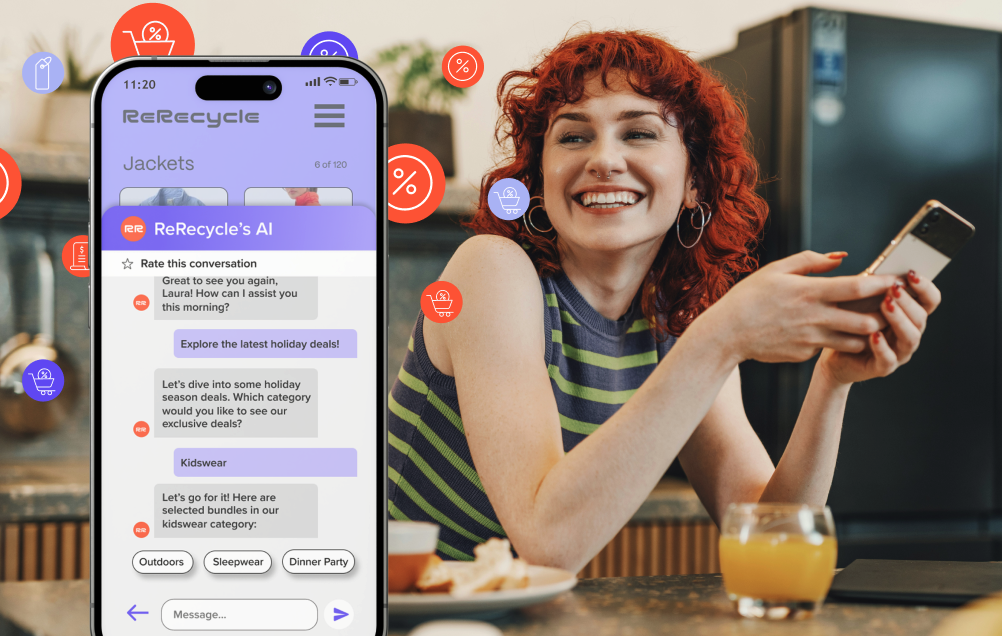Conversational AI in eCommerce: How It’s Transforming the Industry as We Know It
The retail landscape is no stranger to change — especially considering the last few decades. The very first online marketplaces started in the early 1980s. Then Amazon and eBay brought online shopping to the masses in the 2000s. After that, Shopify empowered anyone to start a business with its eCommerce platform. Well, now we're facing another major disruption in the form of conversational AI for retail experiences.

With the wide-reaching implications of tools like ChatGPT, people will soon be able to make purchases as quickly and easily as we do during in-store shopping trips—using speech-to-text tools on eCommerce sites.
Today we’re looking at all things conversational AI—and how it’s already transforming the eCommerce space, including:
- What is conversational AI
- How do conversational AI tools differ from chatbots and voice assistants
- How natural language processing powers these tools
- Examples of conversational AI across industries
- How AI helps eCommerce close the conversion gap on brick-and-mortar
- The benefits of using conversation AI in eCommerce
Armed with this information, you’ll have everything you need to give your customers amazing online experiences that boost customer satisfaction, increase conversion rate, and propel your online retail business to the next level. The tools are here—no more excuses.
What is Conversational AI?
Basically, conversational AI helps humans and machines interact in a more natural and intuitive manner. Using machine learning, natural language processing, and human feedback—as well as massive amounts of textual data—conversational AIs can understand, respond to, and initiate meaningful dialogue with users.
There’s still debate as to whether they actually understand in the same ways we do, but you can leave that to the scientists and philosophers. From a practical standpoint and, more importantly, the customer’s standpoint, these tools provide a more personal, human experience.
A key feature of conversational AI is its ability to recognize language patterns, which gives people the experience of interacting with machines that appear to understand human language. This all happens within a specific context, in real-time. AIs can even interpret the subtleties and nuances of human speech or text, responding in the same way your family member, friend, or live sales rep might.
Businesses across virtually all industries are harnessing the power of conversational AI to deliver superior customer experiences, automate processes, and drive operational efficiencies. In the healthcare sector, AI sets up appointments, provides medication reminders, and answers patient queries round-the-clock. In the banking industry, AI-powered chatbots help with transactions, queries, and even provide financial advice. Even the travel industry leverages conversational AI to assist with ticket bookings, provide personalized recommendations, and offer immediate online support.
But it’s eCommerce where these conversational AIs are positioned to truly overhaul the customer experience (CX).
The birth of Conversational Shopping
Often described as the omnichannel approach to online commerce, conversational AI for retail shopping is an approach that looks to replicate the in-store experience by letting shoppers access sales and support help through an app or chatbot. The difference now? People can use natural language more than ever before.

For eCommerce companies, these tools promise to finally deliver online experiences that align seamlessly with consumer behavior.
By integrating conversational AI with first-generation retail chatbots or live agent platforms like Gorgias, eCommerce companies can gently nudge customers through the sales funnel with timely reminders and notifications—converting browsers into buyers. Additionally, these systems can “learn” the unique preferences of each customer, suggesting products based on recent searches and past buying behavior. Thus, conversational AI not only caters to the customers’ need for immediate, personalized assistance but also helps eCommerce firms increase engagement, build customer loyalty, and boost sales.
But to see exactly how AI will usher in the next era of conversational shopping, you need to understand the difference between chatbots and conversational AI.
What’s the difference between a chatbot and conversational AI?
Despite the fact that both chatbots and conversational AI can simulate human-like conversation, there’s a significant difference between the two: Conversational AI tools are a higher-order iteration of language modeling algorithms. They are trained on vast amounts of data that allow them to respond in fluid and adaptable ways, making human-machine interactions feel much more natural.
In terms of functionality, think of the old, scripted chatbot as the landline at your parent’s place, while AI is the latest smartphone—there’s a world of difference.
Chatbot — Definition and Functionality
Chatbots are rule-based systems programmed to respond to a specific set of language-based commands or keywords. From the simple FAQ bot on a website or an integration that lets you order pizza through a mobile app to the voice assistants like Alexa and Siri that can perform limited tasks based using speech-to-text translation, the OG chatbots have been around for a while, handling even complex issues.
It’s strange to think of chatbots, voice assistants, and interactive voice response systems as “outdated,” or “traditional” tools for human-machine communication, but, to a certain degree, that’s what they are.
And while these tools helped pave the way for novel approaches like voice commerce and conversational shopping, first-generation chatbots are really little more than a fancy user-interface used by major brands to give the illusion of service with a set range of scripted responses and actions.
AI is a whole different animal.
Conversational AI — Definition and Functionality
Conversational AI involves more complex systems designed to understand, process, and respond to human language in a way that is both contextual and intuitive. It goes beyond the rule-based interactions of traditional chatbots, and incorporates sophisticated machine learning algorithms to understand intent, regardless of the language or phrasing used. Conversational AI tools can handle unstructured speech or text inputs, and even improve over time based on additional training and human feedback.
In terms of functionality, conversational AI systems aim to enhance customer engagement by providing holistic, engaging interactions that make them conducive to customer service environments. They can engage in human-like dialogues, remembering past interactions and using this information to shape future responses. This ability to learn from past interactions allows AI-driven chatbots to provide personalized customer service, and to perform sales and marketing tasks more effectively.
Conversational AIs can even proactively engage users based on an understanding of their behavior and preferences to make personalized product recommendations. So, while both conversational AI and traditional tools aim to automate and streamline customer interactions, its the former that offer user-focused interactions.
How does conversational AI work
With Conversational AI 101 out of the way, let’s take a closer look at how these tools actually work. Whether it's a web-based eCommerce chatbot or a text-to-speech shopping tool, all of the latest conversational AIs are built on the same underlying processes.
Natural language processing and understanding
Natural Language Processing (NLP) and Natural Language Understanding (NLU) are fundamental to the current wave of artificial intelligence. These fields produce complicated algorithms that let programs comprehend, interpret, and generate human language in a meaningful, contextually-appropriate way.
NLP is a broader field that encompasses various tasks related to speech and text analysis, such as sentiment analysis, topic detection, and language translation. OpenAI’s various iterations of ChatGPT are one of the most popular, and powerful, examples of an AI built on natural language processing.
NLU is a subfield of NLP that focuses specifically on machine comprehension of input, enabling the AI to understand the intent and context of a conversation, going beyond mere recognition of words and phrases.

In the eCommerce space, these technologies have transformative applications. They power chatbots and virtual assistants, enabling them to understand customer inquiries, provide accurate responses, or make suitable product recommendations.
For instance, when a customer asks for a "red cotton summer dress", an NLU-powered chatbot would understand the specific product attributes — color = red, material = cotton, season = summer, product = dress — and respond with relevant product options. Thanks to NLP, conversational AIs can analyze customer reviews, feedback, and social media mentions to gauge customer sentiment, enabling eCommerce businesses to quickly identify and address issues, and better understand customer preferences and trends.
The best part? NLP tools using AI are constantly learning from both user data and reinforcement from developers, so they continue to get better as you use them.
Real-World Examples of Conversational AI
Brands across a wide range of industries, from insurance to education to transportation, have used chatbots for years to drive key outcomes. The versatility of NLP algorithms means companies are now applying conversational AI’s to core offerings as a way of providing more value to customers. Let’s look at a few examples below.
Humana
Health insurance giant Humana has been using a type of conversational AI to improve the experience of its members by helping them to access care more easily. Using a conversational virtual assistant powered by IBM Watson, Humana breaks down complicated insurance processes and removes barriers to care for millions of customers.
Duolingo
Multibillion-dollar EdTech company Duolingo recently hopped on board the conversational AI train, announcing a new tool powered by OpenAI’s GPT4: Duolingo Max. A premium version of the tool, Max enhances language learning by explaining the issues users are making in real time and offering a Roleplay mode for more authentic, contextually-relevant conversations.
Lyft
Ride-sharing app Lyft has actually been using AI for years — letting customers book rides directly in a Facebook Messenger chat or with Amazon Echo via voice-to-text. These conversational experiences mean Lyft users have a more seamless experience and don’t need to stop what they are doing to find a ride.
Benefits of Using a Conversational AI Platform in eCommerce
The eCommerce industry stands out as an easy winner in the AI arms race. Underneath each product page or fancy graphic, there’s a long string of text—text that a conversational AI eCommerce NLP can process and leverage to improve customer experiences. Here are a few of the major ways conversational AI benefits eCommerce brands.
Satisfy Customers with Real Time Online Shopping Experiences
Conversational AI doesn’t just bring your brand voice to life, it delivers messaging to customers in a way that aligns with their wants, needs, and, most importantly, communication preferences.
Consumers have been craving personalized shopping experiences for years, with support via messaging apps, live agents, and first-generation chatbots. Unfortunately, many eCommerce brands miss the mark across these channels, giving customers impersonal experiences and long wait times.
With conversational AI, true omnichannel marketing is now available to brands in real-time—so customers can get the exact online experience they want across any platform.
Analyze consumer data to provide personalized experiences
Every time a customer visits your eCommerce site, interacts with your brand on social, or sends an SMS or email, they leave a trail of digital breadcrumbs. Previously, you’d then go through your CRM, 3rd party trackers, and the platform’s analytics tools to uncover information about your different consumer segments.
With conversational AI, you can now feed all that data into the AI system and create more targeted content across your off-site sales and marketing channels.
Create Branded AI Sales Rep with Natural Language Processing
One of the ways eCommerce has been lagging behind traditional retail is the lack of authentic, branded interactions. While a sales or support rep at a Patagonia or Apple Store looks and sounds like an extension of the brand, live chat and chatbot windows on eCommerce sites are far less authentic.
With the power of NLP and conversational AI, you can now train an AI sales closer for your eCommerce site that interacts with customers following your exact brand guidelines. Less dry, robotic copy, more engaging experiences with your brand.
Increase the Efficiency of Your Sales and Support Agents
Despite all the hype and fear mongering surrounding AI tools and tools like ChatGPT, there’s no mass replacement happening (at least, not yet…). Actually, when AI is used as an assistant, it can improve the performance of your sales and support teams, and even the efficiency of your overall sales funnel.
For instance, nearly 90% of the queries sales and service agents receive from potential customers are simple, FAQ-style questions. Answering one or two? Simple. But when it scales up to dozens or even hundreds of tickets, delivering a satisfactory customer experience becomes impossible. With Conversational AIs, the chatbot takes care of the easy questions and can hand off any priority tickets to your sales or support team for that human touch. Oh—and they’re also available 24/7.
Aside from freeing up your staff to tackle more complicated issues, ecommerce conversational AI can help you rescue revenue from the large percentage of your site visitors who lose their search intent. By leveraging data on previous user behavior, tools like Rep’s AI concierge can intervene at just the right moment to keep potential customers from bouncing — in May 2023 it rescued $890,532 alone.
Close the Brick-and-Mortar CVR Gap with Conversational AI
With conversion rates that range from 20-40% depending on the vertical, in-store retailers appear to have a massive advantage over their online counterparts. Converting around 2-3% of site visitors into buyers, most eCommerce brands take the lower CVR in exchange for reduced overhead and a massive potential customer base.
With conversational AI, eCommerce brands can close the CVR gap on brick-and-mortar without giving up those benefits. But now you can—with the right tool.
Quick Answers and FAQs
What future trends are emerging for conversational AI in the retail sector?
Conversational AI is reshaping the retail landscape by delivering hyper-personalized and proactive customer interactions. By analyzing user behavior and preferences, these systems initiate tailored conversations, recommend relevant products, and offer customized experiences—enhancing customer relationships while reducing the load on human agents. Moreover, the integration of multimodal interactions, such as text, voice, images, and gestures, results in richer, more intuitive communication that bridges digital and physical shopping experiences.
Rep AI’s platform empowers businesses with capabilities for seamless omnichannel integration and efficient, engaging customer interactions.
What challenges does the retail industry face when implementing conversational AI solutions?
The retail industry faces key challenges with conversational AI: data quality concerns, complex system integration, substantial upfront costs, lack of technical expertise, and slow customer adoption.
Rep AI addresses these issues with its AI concierge, helping merchants deliver personalized service while maximizing visitor engagement.
How do voice bots differ from traditional chatbots in online retail?
Voice bots provide hands-free experiences mimicking conversation, ideal for multitasking. Traditional chatbots excel in text communication with visual interfaces for browsing. Voice bots work where screens aren't available, while chatbots shine where visual detail matters. Retailers integrating both technologies serve diverse preferences, optimizing engagement.
In what ways can conversational AI personalize the user experience for online shoppers?
Conversational AI reshapes online shopping by delivering personalized experiences that mirror in-store interactions. It analyzes a shopper's past behaviors and preferences to suggest products that fit their style, enhancing the journey and streamlining processes like order handling and returns. As these AI systems learn from user interactions, they refine their recommendations.
How does conversational AI help in automating mundane tasks in eCommerce?
Conversational AI revolutionizes eCommerce by automating routine tasks and enriching customer interactions, enhancing business efficiency. It handles customer inquiries like order tracking and product availability 24/7, allowing human agents to address complex issues. By analyzing customer data, these systems deliver personalized product recommendations, guiding users through the purchasing process and improving their shopping experience. Additionally, AI streamlines inventory management by tracking stock levels and updating availability across channels.
How does conversational AI influence digital marketing strategies in the eCommerce industry?
Conversational AI is reshaping eCommerce digital marketing strategies by enhancing customer engagement, offering personalized experiences, and boosting marketing efficiency. These AI-driven systems deliver real-time customer support and personalized content, analyzing user behavior to tailor recommendations and promotions.
They refine analytics and forecasting, allowing businesses to anticipate trends and optimize inventory. Proactive marketing becomes feasible as AI detects emerging trends and adjusts offerings.
What challenges might retail stores encounter when adopting conversational AI technologies?
Retail stores adopting conversational AI may face challenges. Ensuring customer data privacy and security is paramount, especially with regulations like GDPR and CCPA. Creating AI that mimics natural human interactions requires investment in advanced natural language processing.
Seamless integration across platforms while maintaining branding consistency can be complex. Additionally, preparing employees to work effectively alongside AI systems is crucial, considering many may lack AI expertise.
How do virtual agents differ from traditional chatbots in eCommerce?
In eCommerce, traditional chatbots and virtual agents differ mainly in capabilities and customer interaction styles. Chatbots are rule-based, offering scripted responses to basic queries like order status or FAQs, often lacking context-awareness and personalization.
In contrast, virtual agents, powered by advanced AI and natural language processing, understand context, intent, and nuances, providing a more personalized and natural interaction. They handle complex queries, offer tailored product recommendations, and adapt through machine learning.
Can conversational AI effectively replicate natural human conversation for online shoppers?
Conversational AI is advancing rapidly, offering personalized and real-time assistance that aligns with customer communication preferences. These tools, while not perfect, excel in providing immediate responses, handling multiple interactions, and understanding context through natural language processing. However, they may struggle with complex requests requiring human judgment and are limited by their training data.
How does understanding customer expectations improve the effectiveness of conversational AI tools?
Understanding customer expectations is key for effective conversational AI tools. By analyzing customer data and interactions, AI can offer personalized responses that match individual preferences and needs. This not only meets but anticipates customer desires, providing proactive solutions and ensuring consistent, natural conversations across all channels. Understanding these expectations means AI can handle complex queries effortlessly, boosting customer satisfaction and business outcomes.
What types of customer queries can be automated using conversational AI?
Conversational AI can handle various customer service tasks, providing quick responses to common inquiries like FAQs, account management, order tracking, and basic troubleshooting. They enable automated appointment scheduling, billing inquiries, and personalized product recommendations.
They support simple transactions, customer authentication, multilingual assistance, and collect feedback.
By managing these queries, Rep AI optimizes customer interactions, offering 24/7 support without overwhelminng team members, empowering brands to capitalize on every visitor's potential.

.png)










